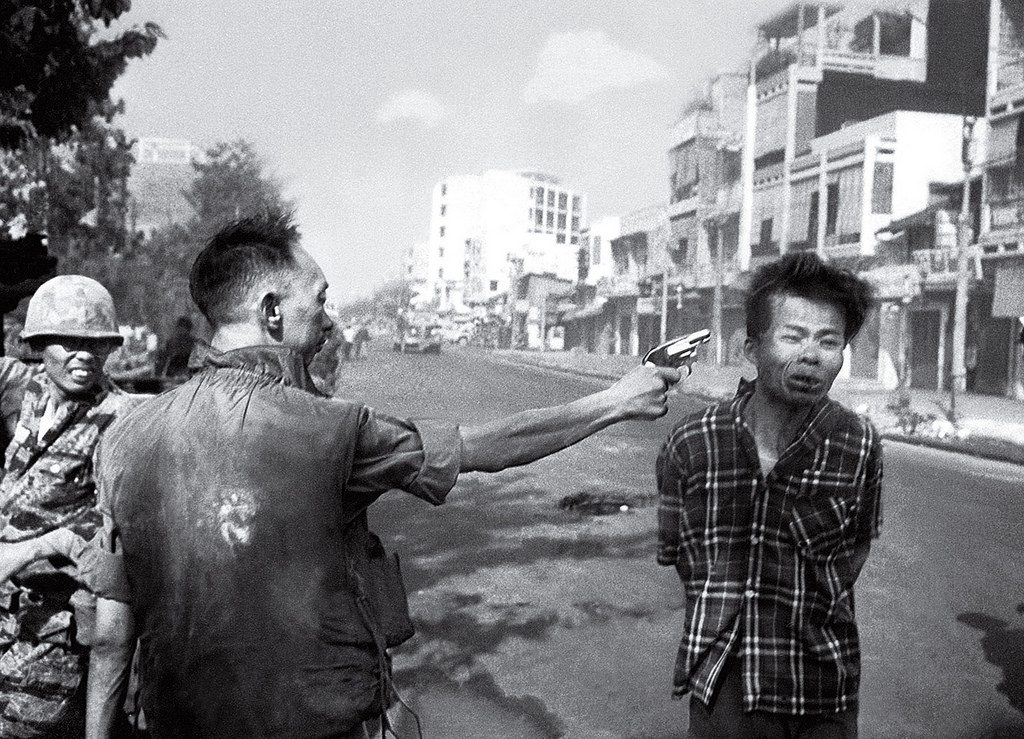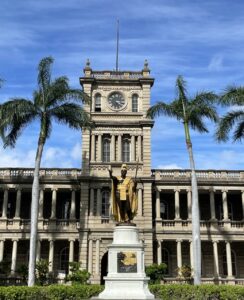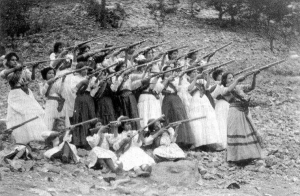Winner of the Fall 2018 StMU History Media Award for
Article with the Best Use of Images
Article with the Best Introduction
The year was 1968. The month of January was almost over and “Tet,” the Vietnamese Lunar New Year, was about to begin. By now, Vietnam had been embroiled for years in a civil war. North Vietnam was under the leadership of a Communist government and South Vietnam was under the leadership of a government that was backed by West. The start of Tet in 1968 was used to launch a huge offensive by the Vietcong in which coordinated attacks took place all over South Vietnam to destabilize the region and push the United States to withdraw.1
The United States‘ intervention in Vietnam began in 1965, a year after the unwarranted attacks by North Vietnam on United States‘ Destroyer ships in the Gulf of Tonkin. By 1967, the number of American troops on the ground surged.2 Despite being involved in this conflict halfway across the globe, the war did not seem so distant with the steady stream of footage and photographs from the front-lines directly to living rooms all over America. In this regard, Vietnam was unique for being one of the first wars to be filmed and photographed extensively.3 The work done by journalists in Vietnam allowed the world to see what was happening in Vietnam firsthand. Among those in Vietnam documenting the war was Eddie Adams.
Eddie Adams had been involved with photography since an early age. He had been a photographer for his high school newspaper and had done some photography work for weddings. Upon graduating high school, he enlisted in the United States Marine Corp. As a Marine, Adams served as a combat photographer in Korea for almost 3 years. In 1965, in what he describes as an “alcoholic haze,” Adams and a close friend decided they would go to Vietnam to document the war.4 During his time in Vietnam is when Adams took the photograph of the Saigon execution.
The day Adams shot the picture featured above was February 1st. He recalls himself and NBC journalists heading toward Cholon, a section of the city of Saigon, because they heard of a battle taking place there. Adams came upon South Vietnamese Brigadier General Nguyen Ngoc Loan executing a Vietcong soldier, in cold blood, in broad day light, in the middle of the street. Adams recalls himself and the other journalist gathering around Loan as he grabbed the soldier. Adams assumed Loan was only going to threaten the man. In the instant Adams raised his camera to snap a photo, Loan raised his pistol and executed the soldier. Loan explained after, that the Vietcong soldier had killed many Americans and allied Vietnamese soldiers.5
The photograph showed up on all major news evening broadcasts and on the front cover of newspapers all over the world the next morning.6 The execution was also recorded, but the specific angle Adams got in his photograph showed the war in an indescribable way. Peter Braestrup, one of the most versed individuals on the Tet offensive, described the picture as a “kind of ultimate horror story that you captured in living color. But in terms of information it told you almost nothing.”7 His quote could not do more justice. What the world saw was a man who was wincing before certain death. They did not know the man was a part of the Vietcong. In the photograph, he seems to be wearing civilian clothes which misleads one. The man had also recently killed allied soldiers and was found armed during martial law- an offense that justifies the use of force.8 Eddie Adams believed he had done an injustice to Loan. He explained, “General Loan was our guy. We were supporting him… believe me, the Americans did just as bad things. I just happened to see this and shoot it…”9

Despite the Johnson Administration’s attempt to win public support of the war, the images of the war painted a very different picture. Public opinion felt that the war was no longer winnable, rather it was now a matter of how America could save face. Walter Cronkite, a well-respected news-anchor and a strong supporter for the war, was among those whose opinion shifted. It was reported that President Johnson believed “if I lost Cronkite, I’ve lost America.”10 The irony of it all was that the Tet Offensive was largely a failure for the Vietcong in terms of land gained and damage inflicted, but in the end its psychological impact on how Americans believed the war to be going, led to its success.11

While this photo was taken out of context, it did provide small truths of the war. Although the war was going well, horrendous acts were being committed. Eddie Adams and many others were able to expose the world to the atrocious acts being committed during the war. Nick Ut’s photo of a napalm strike on a village, is another photo that came to define the war. Ut’s photograph captured the moment children run away in horror from napalm strikes on their village.12 The shattered innocence and utter despair on the childrens’ faces while soldiers seem calm provides a stark incomprehensible contrast that pulls at the heart. These photographs captured only instances of the war. But in the frozen state of a photograph, one is able to examine and reexamine a photograph and truly take in all its details. There was no propaganda campaign that could ever keep a just people supporting a war when they saw photographs like these.

As journalist, Adams and the others were simply doing their jobs. Horst Faas explained about documenting the war, “I don’t think we influenced the war… [he believed simply that the job of journalist was to] record the suffering, the emotions and the sacrifices of both the Americans and the Vietnamese…”13 Their work allowed for the false reality America was living to fall apart. As Americans lived, worked, and played, the very basic rights all humans are entitled to were violated by both sides. As such, Americans responded. In 1973, with public support overwhelmingly against the war in Vietnam, the United States signed the Paris Agreement that led to the withdrawal of all American troops.14 The involvement of the United States in Vietnam continues to be synonymous with some of the most appalling violations of human rights, not only violations against Vietnamese civilians burned alive with napalm or killed slowly through cancer with massive exposure to Agent Orange, but also of the atrocities committed or witnessed by US forces. In addition, all US Soldiers exposed to Agent Orange in indirect ways as when combat medics who worked at Clark Air Force Base (Philippines Islands) received the US soldiers injured in Vietnam who had been evacuated by air. These combat medics received soldiers injured in the field in Vietnam covered in Agent Orange with no protocol for decontamination for the injured nor for themselves as medical personnel. Fifty years on and they continue to die from cancers caused by exposure to Agent Orange. While the US left in 1973, the human suffering due to human rights violations done then, continues today. These images changed the public opinion and changed the course of history even when they may have not saved all those involved at the time, they avoided even greater damages and loss of life, for that we are grateful to these powerful images.
- Patrick Hagopian, America in the World, 1776 to the Present: A Supplement to the Dictionary of American History (Farmington Hills, MI: Charles Scribner’s Sons, 2016), 752. ↵
- James H. Willbanks, Vietnam War: A Topical Exploration and Primary Source Collection (Santa Barbara, CA: ABC-CLIO, 2017), 133, 183. ↵
- James H. Willbanks, The Tet Offensive: A Concise History (New York: Columbia University Press, 2007), 5-6. ↵
- Encyclopedia of World Biography, 2nd Edition, s.v. “Eddie Adams” (Detroit: Gale, 2005), 4. ↵
- Encyclopedia of World Biography, 2nd Edition, s.v. “Eddie Adams” (Detroit: Gale, 2005), 4. ↵
- David Culbert, Television’s Visual Impact on Decision-Making in the USA, 1968: The Tet Offensive and Chicago’s Democratic National Convention, Journal of Contemporary History Vol. 33 (1998): 421. ↵
- David Culbert, Television’s Visual Impact on Decision-Making in the USA, 1968: The Tet Offensive and Chicago’s Democratic National Convention, Journal of Contemporary History Vol. 33 (1998): 424. ↵
- David Culbert, Television’s Visual Impact on Decision-Making in the USA, 1968: The Tet Offensive and Chicago’s Democratic National Convention, Journal of Contemporary History Vol. 33 (1998): 423, 426-428 ↵
- Encyclopedia of World Biography, 2nd Edition, s.v. “Eddie Adams” (Detroit: Gale, 2005), 4-5. ↵
- James H. Willbanks, Vietnam War: A Topical Exploration and Primary Source Collection (Santa Barbara, CA: ABC-CLIO, 2017), 255. ↵
- James H. Willbanks, Vietnam War: A Topical Exploration and Primary Source Collection (Santa Barbara, CA: ABC-CLIO, 2017), 249 ↵
- Hal Buell, The Napalm Girl, Vietnam 25, no. 1 (June 2012), 36-39. ↵
- Deborah Stadler, Frontline Focus, Military History 33, no. 6 (March 2017), 56-61. ↵
- “12 Address to the Nation Announcing Conclusion of an Agreement on Ending the War and Restoring Peace in Vietnam. January 23, 1973.” 2001. American Reference Library – Primary Source Documents, (January, 1.) ↵



188 comments
Didier Cadena
This was a very interesting article. I was unfamiliar with the photo and its backstory, so that was nice to read about. It is great to read about how the attitude and view of the war was able to be shifted by pictures, showing how much significance a photo can have. The article does a great job of putting all of the information together and sill make it interesting to read.
Daniela Cardona
The title of this article pulled me in quickly. I have always found photography, and photo journalism, to be so important. We can read about what is going on in our world but until we see what it really looks like, how people are actually living and dying, nothing will change. For one picture to basically end a war is mind blowing. I think it is an important testament of who we our as people; that we are not so self involved and we do want to help our fellow man. At the same time though, it takes us some time to get there.
Tyanne Pearcy
This article was very enticing as the title suggest that a picture stopped a Vietnam War. It is crazy that Adam happened to be perfectly placed where the Vietcong soldier was executed so brutally in the middle of the street and his first instinct was to capture the moment. The picture opened the publics eyes, and made known the horrors that were really going on during this time.
Nathan Alba
I think this article was written quite well. I think it also goes to show what the impact of information can be when not fully understood or taken out of context. Don’t get me wrong, horrendous things happen during a time of war, but also who knows what these soldiers went through or saw? Things like that can change a person, and sometimes not for the better. It is easy for outsiders to judge, but hard for them to really understand.
Megan Copeland
It is so crazy that one single picture ended the Vietnam war. Pictures really are worth a thousand words. I think this article was very well written and researched. It provided many details about the Vietnam war. It is so sad that so many lives ended during this time period. I am glad the Vietnam War ended when it did because I feel like the amount of deaths could have been so much worse.
Luke Lopez
This was a very interesting article on the Vietnam War. I did not know that Eddie Adams was the photographer, who took the famous photo of the Vietnamese general executing the Viet Cong Lieutenant. Without any background information when looking at the photo, it looks like a Vietnamese soldier is about to shoot a civilian in cold blood. Overall, this was a great article that showed the impact of a single photograph on the entire Vietnam War.
Daniel Linstead
It is amazing to think that a picture, that doesn’t have any words can communicate. This picture was able to capture so many emotions that was able to end a war. This makes me feel that sometimes words just complicate everything, just like music can bring up emotions and able to make a feel a certain way and it can do it without words.
Bictor Martinez
I was in awe when I read the title of this article. I thought to myself how could a picture end an entire war? Then I remembered that a picture equals a thousand words that capture so many emotions. Words are just written down but photography is a whole different story. Thanks to Adam the whole world was able to visually see what was going outside of their country and if it were not for Adam, the Vietnam War could have gone on for much longer.
Harashang Gajjar
If the broader Tet offensive revealed chaos where the government was trying to project control, Adams’s photo made people question whether the United States was fighting for a just cause. Together, they undermined the argument for the war on two fronts, leading many Americans to conclude not only that it could not be. won, but also that, perhaps, it shouldn’t The photo fed into a developing narrative in the wake of the Tet offensive that the Vietnam War was looking more and more like an unwinnable war, said Robert J. McMahon, a historian at the Ohio State University.
Nathan Hartley
I have never seen this picture before, but I can’t imagine the state that Vietnam was in during the Vietnam war. I think it is important that during times of war, we have actual evidence of the events coming back to us so we can be informed on the events that are actually happening. I think that pictures like this one show us what life was really like.